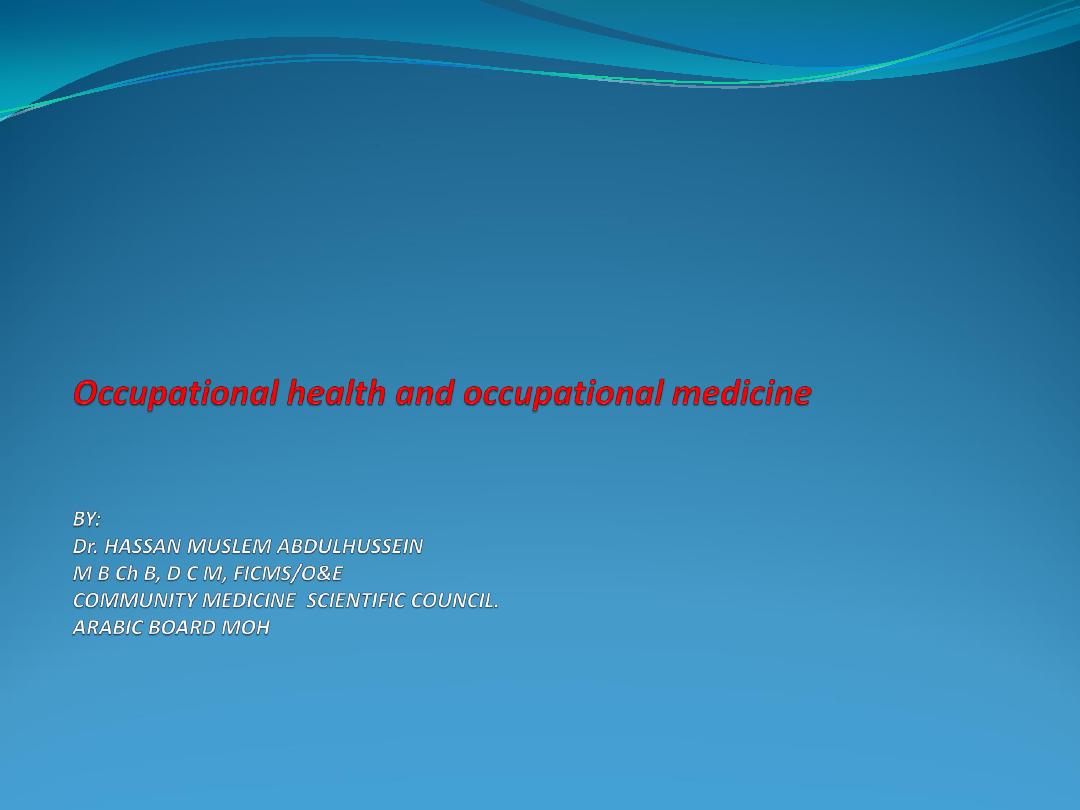
1 May 2016
1

Occupational health and occupational
medicine
:
The importance of health of the workforces
(a healthy workforce is vital for sustainable social
and economic development on a global and
national level).
The classic approach to ensure health and safety in
the workplace, is through two main principles :
- Legislation.
- Inspection.
1 May 2016
2

Reasons of non effectiveness of the classic approach in
controlling many specific occupational hazards :
First-
the development of private enterprises.
Second-
introduction of new agricultural techniques.
Third-
occupational health problems have gradually
increased in type and magnitude and have led to or
aggravated disease resulting from exposure to several
risk factors (like work environment).
1 May 2016
3

Occupational Health and it’s relation with
International Organizations:
-Alma-Ata (1978).
-WHA 40.28 (1987).
-EM/RC-38/R.8.(1991)&(1997).
-I.L.O.
*
RAMAZZINI, BERNARDINO
(1633-1714) An Italian
physician, “Father of Occupational Medicine” he published
De Morbis Artificum (On the Diseases of Workers) in1700.
Based on observation and anecdote, this was the first
systematic account of diseases related to workplace
exposures.
1 May 2016
4

Introduction
lack
, and
working conditions
and
poor living
,
Poverty
have been repeatedly identified as major
of education
impediments to health. Over the years it has become
clear that substantial improvements in health cannot
be achieved without improvement in social and
economic conditions.
1 May 2016
5

It was explicitly noted that this could be attained only
through a fuller and better use of the world’s resources:
“
health is only possible where resources are available to
meet human needs and where the living and
working
environment is protected from life-threatening and
health-threatening pollutants, pathogens and physical
hazards
" (WHO).
1 May 2016
6

•
Environmental pollution and degradation have a huge
impact on people’s lives.
•
Every year hundreds of millions of people suffer from
respiratory and other diseases associated with indoor
and outdoor air pollution.
•
Hundreds of millions of people are exposed to
unnecessary physical and chemical hazards in the
work place and living environment.
1 May 2016
7

1 May 2016
8
•Half a million die as a result of road-traffic
accidents (RTA).
• Four millions infants and children die every
year from diarrheal diseases, largely as a result
of contaminated food or water.
•Hundreds of millions of people suffer from
debilitating intestinal parasites. Two million
people die from malaria every year while 267
million are ill with it at any given time.

-Three million people die each year from TB and 20
million are actively ill with it.
-Hundreds of millions suffer from poor nutrition.
Almost all of these health problems could be
prevented (WHO).
* As noted in the book Our Planet, Our Health (WHO),
the responsibility for protecting and promoting good
health extends to all groups in society.
1 May 2016
9

*No longer is good health the responsibility of only
traditional health care professionals, such as doctors,
nurses, sanitary engineers, and safety officers, who
seek to cure disease, care for the sick, remove
pathogens, and reduce injuries.
*Now clearly the responsibility of planners, architects,
teachers, employers, industrial managers, and all
others who influence
the physical, mental and social
wellbeing of workers in all occupations.
1 May 2016
10

Economic and Industrial Development and
Environmental health
While it is well known that biological agents and
naturally occurring chemical and physical hazards
have exited throughout human history, there is
also along history of environmental pollution from
anthropogenic sources (human activities).
1 May 2016
11

*Even in ancient times, sites of production and
manufacturing were contaminated with pollution.
A good example is lead contamination in the area
around smelters centuries ago and the horrible
odor and water pollution associated with
tanneries.
*By modern standard, the scale of most of these
enterprises was very small, however. The
technology was that of individual artisan using
traditional work practices that had not
substantially changed for centuries.
1 May 2016
12

*The resulting pollution was usually restricted to the
immediate area. Pollution from human waste was
considered more of a problem, as it effectively limited
the size of cities.
*As great a problem as pollution was occupational health
and safety, as workers were subjected to intense
exposure to variety of hazards at the workplace.
1 May 2016
13

*The Industrial Revolution marked a dramatic turning
point in the interaction between economic activity and
the environment.
*Industrial pollution was first identified as an obvious
and serious issue in the early 1800s, when it became
obvious that production on an industrial scale, using
the breakthrough technology of the time, resulted in
pollution on a scale never before seen.
1 May 2016
14

*This pollution was largely the result of the energy
requirements of a technology based on iron and steel,
which led to more widespread air pollution as well as
local concentrations of pollution near the factory site.
1 May 2016
15

Occupational Health:
is a
multidisciplinary activity, defined by
I.L.O.
(
International Labor Organization
),
as the promotion and maintenance of highest degree
of physical, mental and social wellbeing of workers in
all occupations, aiming to protect worker’s health at
their work places.
1 May 2016
16

Occupational Health Classification:
Is classified or divided into
three
main
Categories;
Occupational Medicine.
Occupational Safety.
Occupational Hygiene.
Recently occupational safety and hygiene are integrated.
Nowadays occupational health includes
(occupational accidents, occupational diseases and work
related diseases).
1 May 2016
17

Occupational Medicine:
Mainly preventive in nature, include
different subspecialties or types,
which are:
1.
Industrial Medicine.
2.
Agricultural Medicine.
3.
Navigation Medicine.
4.
Sport Medicine.
5.
Military Medicine.
6.
Aviation Medicine.
1 May 2016
18

risk identification at the work
:
Occupational Safety
place and preventive measures taken to reduce or
eliminate the hazards which may lead to accidents.
is the practice of assessment
:
Occupational Hygiene
and control of environmental factors and stresses
arising in or from the workplace, which may cause
injury, sickness, impaired health and wellbeing or
significant discomfort and inefficiency among workers
or among the citizens of the community .
1 May 2016
19

*
Activities of Occupational Medicine :
1.
Medical exam. Of the workers;
a. pre employment exam.
b. periodic exam.
2. First –aid facilities.
3. Health education.
4. Rehabilitation.
5. Epidemiological studies and medical
records.
6. Environmental and biological
monitoring.
1 May 2016
20

*
Types of occupational hazards :
1.
Physical hazards (noise, vibration, temperature,
electricity, radiation, light and pressure ).
2.
Chemical hazards (dust, mists, fumes, gases,
fibers, vapors and liquids).
3.
Biological hazards (insects, mites, moulds,
yeasts, fungi, bacteria, viruses and parasites) .
4.
Ergonomic : fitness of the work process and
work place to the workers (posture, movement,
repetitive motion and light) .
5.
Psychological hazards (tension, stress, and
phobia) .
6.
Accidents and mechanical hazards
.
1 May 2016
21

*
General control measures of occupational hazards :
1.
Elimination by substitution.
2.
Isolation of the process .
3.
Total enclosure of the process.
4.
Suppression of the emission .
5.
Shielding of the source or worker.
1 May 2016
22

6.
Locally applied exhausted ventilation.
7.
General ventilation .
8.
Reduce time of exposure .
9.
Personal protective equipment with personal
hygiene
10.
Health education to the workers (information,
training and instruction) .
11.
General cleanliness .
12.
Personal hygiene .
13.
Maintaining control : a. pre employment exam .
b. periodic medical exam .
c. monitoring procedures .
1 May 2016
23

:
Occupational diseases
*
Are adverse health conditions in the human being, the
occurrence or severity of which is related to exposure to
factors in the job or in the work environment, such
factors can be;
physical, chemical, biological, ergonomic, psychological
or mechanical .
1 May 2016
24

Characteristic of occupational diseases :
The occupational cause of occupational disease is
often overlooked by health care providers . This is due
to several special characteristics of occupational
diseases that may obscure it’s occupational origin :
1 May 2016
25

Characteristic of occupational diseases :
The clinical and pathological presentation of most
occupational diseases is identical with that of non-
occupational, e.g.: asthma due to airborne exposure to
toluene diisocyanate is clinically indistinguishable from
asthma due to other causes.
Occupational disease may occur after the termination of
exposure, e.g.: asbestos – related mesothelioma ( cancer of
the lung and abdomen) which can occur 30-40 years later .
The clinical manifestation of occup. dis. are related to the
dose and timing of exposure, e.g.: different doses and time of
exposure to mercury.
Occupational factors can act in combination with non –
occupational factors to produce disease, e.g.: exposure to
asbestos alone increase the risk of lung cancer 5 folds, also
the long term smoking of cigarettes increase risk of lung
cancer about 50-70 folds .
1 May 2016
26

*
Occupational Health Services
:
Is defined by I.L.O as (the services which are mainly
concerned with preventive function and responsible for
advising the employer, the workers and their
representative on the requirement for establishing and
maintaining a safe and healthy working environment
which will facilitate optimal physical and mental health
in relation to work and the adaptation of work to the
capabilities of workers in the light of their state of
physical & mental health).
1 May 2016
27

Occupational health services is
a team work
and not
merely a single person work, the leader of the team
should be a physician because of his knowledge and
experience, others like occupational engineering,
technician and environmental workers have a
contributory function .
1 May 2016
28

*
Functions of occup. health services :
1.
Preliminary orientation to the enterprise (for new occup.
Health services staff ).
2.
Surveillance of the working environment,
(surveillance means continuous systemic collection,
analysis, interpretation of health
data that are important for planning, implementation and
evaluation of the health program ) .
3.
Informing employer, enterprise management and
workers about occup. health hazards .
4.
Assessment of health risks (to compare worker’s
exposure with TLV – Threshold Limit Value –or if the
substance used known to be carcinogenic ) .
5.
Surveillance of worker’s health .
1 May 2016
29

6.
First –aids services and emergency preparedness
7.
Occup. health care, general preventive and curative health
services .
8.
Rehabilitation .
9.
Adaptation of work to workers (Ergonomics ) .
10.
Protection of vulnerable groups .
11.
Information, education and training .
12.
Health promotion activities .
13.
Data collection and record keeping .
14.
Researches .
15.
Internal collaboration .
16.
External collaboration .
1 May 2016
30

*
Basic functions of occup. health physician and occup.
health worker at work place :
1.
Fitting the person in right place of work .
2.
Provide treatment services .
3.
Controlling the recognized hazards at work place through
maintenance of TLV of the dangerous substances .
4.
Identification and recognition of hazards .
5.
Avoiding the potential risk by planning with help of
hygienic economist .
6.
Screening for early evidence of occup. and non occup.
diseases .
1 May 2016
31

7.
Supervising of vulnerable groups of people or workers (e.g. :
young, pregnant, asthmatic, diabetic and hypertensive
patients) .
8.
Counseling .
9.
Surveillance of working environment .
10.
Health education and training for first aids.
11.
Advice to management and worker’s representative .
12.
Environmental control outside work place .
13.
Periodic review of statistics concerning the health
conditions and data keeping .
14.
Medical and health researches .
1 May 2016
32

SICKNESS ABSENCE:
One of the most important tools for evaluation of occup.
health is the study of sickness absence, which is the
absence from the work accepted as attributable to sick or
injury, although could be due to psychological or social
problems, (usually the absence due to pregnancy not be
included in the study of sickness absence).
• There are
three
main factors affecting the persons to have
sickness absence (which depend or based on three
principles of workers, work itself and work place or
environment);
1 May 2016
33

SICKNESS ABSENCE: (contin.)
1.Personal factors
(worker’s factors), e.g.: age, sex, family
responsibility, (the number of spills coming down as the age of
the worker coming up, the females take more spills than
males).
2.Organization factors
(work or job factors), e.g.: type and size
of the factory, management attitude, supervisory quality,
sickness pay, working conditions and medical services.
3.Regional factors
( work place or environment), e.g.:
geography, season and epidemiologic distribution.
( Sickness Absence cause problems to the community and
cost money).
1 May 2016
34

®
(occupational physician’s
Control of sickness absence:
duty), is by the following:
1
.Identify the problem which can be medical, social or
behavioral.
2
.Prevent the occurrence of illness in order to decrease disease
incidence.
3
.Reduce duration of absence.
4
.Apply effective resettlement.
1 May 2016
35

:
NOTIFIABLE DISEASES
Are group of diseases when occur in a factory are
by the doctor and employer to the
notifiable
compulsory
chief inspector of that factory, which include;
1.
Aniline poisoning,
2.
Anthrax,
3.
Arsenic poisoning,
4.
Beryllium poisoning,
5.
Cadmium poisoning,
6.
Carbon disulphide Poisoning,
7.
Chrome poisoning,
1 May 2016
36

(contin.)
NOTIFIABLE DISEASES
8.
Chronic Benzene Poisoning,
9.
Decompression sickness,
10.
Epithliomatous dis.
11.
Lead Poisoning,
12.
Manganes Poisoning,
13.
Mercurial Poisoning,
14.
Phosphorus poisoning,
15.
Toxic Anemia,
16.
Toxic Jaundice.
1 May 2016
37

:
PRESCRIBED DISEASES
)
compensation are payable
Are those diseases which (
under the act, provided the condition arise as a result
of specified employment.
They include all notifiable diseases and others.
:
NOTE
all occupational diseases are preventable if we know
Where
,
When
,
How
and
What
to look for.
1 May 2016
38

*
Staff of occup. health services center:
Depend on;
*
nature of the industry.
*
size of industry &number of workforces.
*
availability of specialist.
*
financial resources.
1 May 2016
39

:
Staff of occup. health services center
The staff is acting as
a team work,
which include;
occupational physician, occup. health worker, safety
engineer, mental health specialist, work physiologist,
ergonomist, physiotherapist, toxicologist,
epidemiologist, and health educator. (Generally in
Europe
one
physician and
two
nurses serve
2000-7000
workers).
1 May 2016
40

million
5
there are about
Size of the problem:
chemicals, in different work places we only know
120.000
of them, and according to the document,
there are
250 million
accidents happen in the work
among which
330.000
are fatal, there are
160
million
new cases of occup. diseases.
International Labor Organization (I.L.O) at 1999,
had published that : there are
1.1
million
deaths in
work place,
34%
of them were due to accident.
Accident occupy
third
rank in the scale of
ten
leading
cause of death, economically accidents cost
14%
of
the National Gross Product (NGP).
1 May 2016
41

The major hazards and challenges facing occup.
health services :
1.
Chemical safety.
2.
Radiation protection.
3.
Working of children and young persons.
4.
Diseases pattern in children.
5.
Occupational Injuries.
6.
Behavioral disorders.
7.
Relation between occupational health and
productivity.
1 May 2016
42

Assessment of exposure:
1.Environmental assessment: work place and
surrounding .
2.Biological assessment: blood, urine and enzymes.
3.Medical examination; - pre-employment exam.
-periodic exam.
-and screening tests.
1 May 2016
43

-
RELATED DISEASES:
-
WORK
This category has certain characteristics which were
identified and stated by the
WHO Expert
Committee
as follows:
Multifactorial diseases which may frequently be
work- related, also occur among the general
population, working conditions and exposures need
not be risk factors in each case of any one disease.
1 May 2016
44

RELATED DISEASES: (contin.)
-
WORK
However, when such diseases affect the workers, they may
be partially caused by adverse working conditions, they
may be aggravated, accelerated or exacerbated by work
place exposures, and they may impair working capacity. It
is important to remember that personal characteristics,
other environmental and socio-cultural factors usually play
a role as risk factors for these diseases.
1 May 2016
45

Multifactorial
work-related diseases
are often more
common than occupational diseases and therefore
deserve adequate attention by the health services
infrastructure, which incorporates the occup. health
services. The work-related diseases which deserve
particular attention are;
1
.Behavioural and psychosomatic disorders.
2
.Hypertention.
3.
Coronary heart diseases.
4
.Peptic ulcers.
5
.Chronic nonspecific respiratory diseases.
6
.Locomotor disorders.
1 May 2016
46

®
Prevention of occupational diseases:
Primary prevention
;
by reducing the risk of diseases which is most
commonly done by- reducing the magnitude of
exposure to hazardous substances, through
change in production process, e.g.: substitution of
hazardous substance with a safer one or enclosure
or special ventilation or using of personal
protective equipments, which are known as
engineering controlling measures.
1 May 2016
47

Secondary prevention
;
by identifying health problems before they
become clinically apparent and intervening to
limit the adverse effects (also known as
occupational disease surveillance), e.g.: blood
lead level measurement in exposed workers.
1 May 2016
48
Prevention of occupational diseases: (contin.)

Tertiary prevention
;
by minimizing the adverse clinical effects on
health of a disease or exposure, e.g.: changing the
type of job, giving aids like hearing aids to workers
suffering from sensory- neural hearing loss
(SNHL), which may result from chronic exposure
to noisy sound.
1 May 2016
49

GOOD LUCK &
THANK YOU
1 May 2016
50
